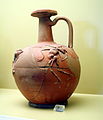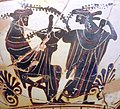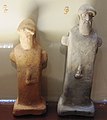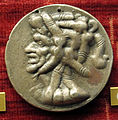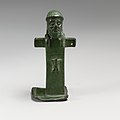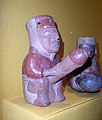Category:Ithyphallic representations
Jump to navigation
Jump to search
English: The word derives from the Greek ἰθυφαλλικός from ἰθύς (ithǘs "straight" "right") and φαλλός (phallos "phallus"), and indicates any representation characterized by an erect or disproportionate phallus. The use of ithyphallic representation in many ancient artifacts around the world commonly symbolized fertility or abundance and were often used in religious rites and ceremonies. Some ithyphallic objects, such as the ancient Roman fascinum or some Greek hermai, were believed to have an apotropaic function or protective qualities.
Italiano: Il termine deriva dal greco ἰθυϕαλλικός da ἰθύς (ithǘs "dritto" "retto") e ϕαλλός (phallós "fallo"), quindi indica qualsiasi rappresentazione caratterizzata da un fallo eretto o smisurato. L'uso dell' iconografia itifallica in molti manufatti antichi in tutto il mondo testimonia il suo valore nel simboleggiare la fertilità e l'abbondanza, e il suo frequente uso in riti e cerimonie religiose. Si ritiene che alcuni oggetti itifallici, come il romano fascinum o alcune hermai greche, avessero una funzione apotropaica o funzioni protettive.
related to an erect penis | |||||
| Upload media | |||||
| Instance of | |||||
|---|---|---|---|---|---|
| |||||
Subcategories
This category has the following 20 subcategories, out of 20 total.
A
- Aphroditus (17 F)
C
E
H
K
- Karditsa Thinker NAMA 5894 (10 F)
L
M
- Man-E 27457 (5 F)
P
- Phallophoria (3 F)
S
- Ithyphallic Shiva (24 F)
T
- Tychon (4 F)
U
Media in category "Ithyphallic representations"
The following 108 files are in this category, out of 108 total.
-
Delle antichità di Ercolano, 1757-1779 (T. I-VII) 60400 (23248249964).jpg 2,867 × 4,118; 1.32 MB
-
Flögel1862 13 Drillops Morion Drillops.jpg 1,115 × 855; 385 KB
-
Fertility stele, Fontaine Notre-Dame-des-Fontaines (Nojhan - IMG 8786).jpg 2,304 × 3,456; 3.69 MB
-
074 Statue très ancienne près de Notre-Dame-des-Fontaines.jpg 2,304 × 3,072; 1.79 MB
-
Vasetti a forma di maschera con fallo mobile, I sec. dc, Santangelo 908, 125169.jpg 2,304 × 1,366; 1.86 MB
-
Stolido, caricatura del filosofo cinico, da pompei, I sec dc, 27729.JPG 960 × 2,797; 1.82 MB
-
Coll. borgia, testina con naso adunco e fallo sulla fronte, inv. 27852.JPG 864 × 1,400; 719 KB
-
Vervin Figurines from Pompei.JPG 3,264 × 2,448; 2 MB
-
Vasetti a forma di maschera con fallo mobile, I sec. dc, 27859.JPG 1,512 × 1,576; 1.66 MB
-
Lucerna in bronzo a forma di nanerottolo danzante, da pompei, I sec dc, 27870.JPG 1,182 × 2,706; 1.73 MB
-
Lucerna in bronzo a forma di nanerottolo danzante, da pompei, I sec dc, 27871.JPG 1,368 × 2,372; 1.65 MB
-
Lucerna in bronzo a forma di nanerottolo danzante, da pompei, I sec dc, 27872.JPG 1,239 × 2,221; 1.53 MB
-
A figure in the form of a phallic motif. Photomechanical pro Wellcome V0038919.jpg 2,400 × 3,001; 2.12 MB
-
Adulteror? Vision and scenes of Hell! (3558853786).jpg 1,024 × 680; 394 KB
-
Ajrud.jpg 1,366 × 2,048; 143 KB
-
Akha Funeral3.JPG 800 × 1,066; 212 KB
-
Amth71.jpg 4,767 × 3,175; 5.2 MB
-
Amth77.jpg 3,196 × 2,909; 2.93 MB
-
Amth88.jpg 3,709 × 4,155; 5.11 MB
-
Ancient Greek bone objects - AGM.jpg 3,716 × 3,681; 5.05 MB
-
Handbuch der Sexualwissenschaften p592.jpg 1,904 × 897; 2.45 MB
-
Anonimo, medaglia satirica con testa composta da membri virili, arg..JPG 1,872 × 1,908; 2.18 MB
-
Aphrodite crowning a herm BM GR1890.11-5.1.jpg 2,215 × 3,334; 5.35 MB
-
Barrel man revealed.jpg 1,536 × 2,048; 809 KB
-
Bell krater - 2 - Museum number 1772,0320.154.jpg 2,500 × 1,876; 593 KB
-
Black figure skyphos, AM of Thebes, 201194.jpg 5,276 × 3,511; 9.58 MB
-
Black-figure skyphos, Dionysos with phallic cup, 500 BC, AM Thebes, 0108.jpg 1,627 × 1,127; 935 KB
-
Boruta god S.jpg 1,280 × 1,664; 1.73 MB
-
Bronze herm MET DP21007.jpg 1,960 × 1,960; 294 KB
-
Bronze herm MET DT6197.jpg 3,200 × 4,000; 2.05 MB
-
Bronze herm MET GR159.jpg 379 × 700; 42 KB
-
Bronze herm MET GR160.jpg 358 × 700; 42 KB
-
Castello di bodrum, torre del serpente, piano superiore, statuetta di asclepio.JPG 964 × 1,804; 1.06 MB
-
Ceremonial pole DMA 1974-51 img02.jpg 1,821 × 2,448; 2.77 MB
-
Champollion - Panthéon égyptien, 1823 (page 215 crop).jpg 4,448 × 3,350; 1.97 MB
-
Clay anthropomophic rhyton, 2700-2500 (?) BC, 980006.jpg 1,177 × 1,569; 1.78 MB
-
Copulerende man en vrouw-Rijksmuseum RP-P-2004-153.jpeg 2,586 × 1,846; 3.37 MB
-
Ein Carmel-Basalt sculpture-female.jpg 1,806 × 2,410; 3.16 MB
-
Figura itifálica ibera (M.A.N. Madrid) 01.jpg 1,738 × 2,834; 1.21 MB
-
Flögel1862 11 Vasengemälde.jpg 684 × 959; 420 KB
-
Fro (statue en grès, Arras).jpg 2,920 × 3,728; 2.5 MB
-
Horvat Teman's couple and 'Yahweh and his Asherah' inscription.jpg 338 × 547; 63 KB
-
Ithyphalic stone, Sitia, 3000 BC, AM Ag. Nikolaos, 0501208.jpg 2,194 × 3,204; 4.81 MB
-
Ithyphallic male figurine on a bird, terracotta, 700-600 BC, AM Thebes, d0111.jpg 1,068 × 1,424; 796 KB
-
Ithyphallic slave Louvre Myr332.jpg 1,675 × 2,550; 2.43 MB
-
Ithyphallic Statue, Candi Sukuh 1238.jpg 2,304 × 3,072; 6.49 MB
-
Ithyphallisch dargestellte Boxer.jpg 3,835 × 2,558; 1.33 MB
-
Kabeiric black-figure skyphos, Kaberion, 430-400 BC, AM Thebes, 01151.jpg 1,425 × 1,135; 1.19 MB
-
Kurupi-detoured.jpg 1,202 × 1,804; 696 KB
-
Kurupí.jpg 1,536 × 1,804; 1.64 MB
-
Late Neolithic figurine of Thinker type, AM of Thebes, 201107.jpg 2,173 × 3,259; 5.65 MB
-
Male figurine, bronze, Greek geometric style, AM Ioannina, Ioam14.jpg 746 × 1,119; 562 KB
-
Male figurines, clay, Middle Minoan, 2000-1425 BC, AM Ag. Nikolaos, 0501237.jpg 1,728 × 1,152; 1.28 MB
-
Male figurines, clay, Middle Minoan, 2000-1425 BC, AM Ag. Nikolaos, 0501238.jpg 3,456 × 2,304; 4.67 MB
-
Male figurines, clay, Petsophas, 2000-1425 BC, AM Ag. Nikolaos, 0501227.jpg 1,728 × 1,152; 1.35 MB
-
Male figurines, clay, Petsophas, 2000-1425 BC, AM Ag. Nikolaos, 0501228.jpg 2,220 × 2,933; 3.69 MB
-
Male figurines, clay, Petsophas, 2000-1425 BC, AM Ag. Nikolaos, 0501229.jpg 1,684 × 1,136; 1.32 MB
-
Mandrake root, England, 1501-1700 Wellcome L0058458.jpg 2,832 × 4,256; 1.02 MB
-
Pompei - House of Menander - Caldarium.jpg 2,118 × 3,405; 3.04 MB
-
Mosaico marino de Pompeya.jpg 1,362 × 897; 426 KB
-
Musée d'Ensérune - Figurine 2.jpg 6,000 × 4,000; 12.67 MB
-
Musée de l'érotisme 005.jpg 3,456 × 2,296; 3.97 MB
-
Myrina, afrodite con incorona un'erma di dioniso, 150-100 ac..JPG 706 × 1,314; 555 KB
-
Neith Génératrice (Athénè, Physis, Minerve), N372.2 C35.jpg 1,536 × 1,250; 505 KB
-
Neolithic findings from the Kitsos cave, AM Lavrion, 190055.jpg 5,266 × 3,511; 9.57 MB
-
Neolithic findings from the Kitsos cave, AM Lavrion, 190057.jpg 5,223 × 3,482; 9.71 MB
-
Nias Island sculpture Inv70-1999-5-1.jpg 950 × 2,100; 1.14 MB
-
O Deus do Sexo (2882982563).jpg 480 × 640; 205 KB
-
Olympiamuseum013.jpg 2,560 × 1,696; 2.89 MB
-
Pan Musée Mariemont 08112015.jpg 1,568 × 3,480; 2.33 MB
-
Perù, moche, vasi di uso funerario 10.JPG 1,124 × 1,356; 660 KB
-
Phallic kokopelli.png 125 × 218; 1 KB
-
Phallus at the Naples Museum in Italy.jpg 1,135 × 1,589; 1.64 MB
-
Phallus, Ancient Roman relief, AM Ephesus, EFEM15.jpg 1,543 × 1,157; 1.56 MB
-
Pittore di pan, cratere a colonna con culto di fallo, attica 470 ac ca., da etruria 03.JPG 2,228 × 1,704; 2.06 MB
-
Priapos gem drawing.jpg 570 × 783; 123 KB
-
Priapus on the door post of Bakery VII 1,36 Pompeii Prowalk.jpg 1,152 × 606; 707 KB
-
Red figure amphora, 480-475 BC, nude woman, falloi, AM Syracuse, 121439.jpg 2,311 × 3,471; 4.16 MB
-
Red figure amphora, 480-475 BC, nude woman, falloi, AM Syracuse, 121439x.jpg 1,942 × 1,942; 1.87 MB
-
Red figure Pelike from Perachora, NAMA, 17170, 191311.jpg 3,220 × 4,830; 9.2 MB
-
Rops-Louis-XIV.jpg 1,947 × 2,241; 232 KB
-
Yogi. Mold of Seal, Indus valley civilization.jpg 888 × 913; 570 KB
-
Shiva Pashupati.jpg 920 × 926; 1.4 MB
-
Small herm of ithyphallic Hermes, clay, Olous, 700-400 BC, AM Ag. Nikolaos, 0502005.jpg 1,528 × 3,094; 2.77 MB
-
Small marble Aphrotide ithyphalica Museum Delos 6022 Zde0502284.jpg 2,197 × 3,311; 2.74 MB
-
Small marble Aphrotide ithyphalica Museum Delos 6022 Zde0502285.jpg 2,197 × 3,391; 5.33 MB
-
Small marble Aphrotide ithyphalica Museum Delos 6022 Zde060275.jpg 2,197 × 3,311; 7.28 MB
-
Taiyo-koen P7110195.jpg 960 × 1,280; 410 KB
-
Telesphorus, Oil lamp, terracotta, 100-200 AD, Agora Museum Athens, 080650.jpg 2,742 × 2,024; 2.73 MB
-
The Cobbler at Cobbler's Cliff Backa Brastad overhead view.jpg 4,885 × 8,165; 33.17 MB
-
Thomas Rowlandson (36).jpg 542 × 652; 104 KB
-
Three headed Osiris taking an oath, Phallic worship. Wellcome M0010557.jpg 2,844 × 3,765; 3.07 MB
-
Verbonden penis-Rijksmuseum RP-P-2004-154.jpeg 2,514 × 1,870; 3.46 MB
-
Visantet el Pardalut.jpg 936 × 1,391; 298 KB
-
Waterdrager-Rijksmuseum RP-P-2004-149.jpeg 2,658 × 1,906; 3.76 MB
-
Wood carving in Aitutaki.jpg 600 × 800; 75 KB











